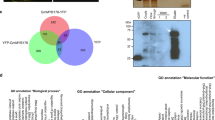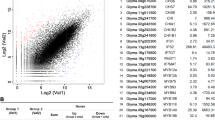Abstract
Soybean flavonoids, a group of important signaling molecules in plant-environment interaction, ubiquitously exist in soybean and are tightly regulated by many genes. Here we reported that GmMYB100, a gene encoding a R2R3 MYB transcription factor, is involved in soybean flavonoid biosynthesis. GmMYB100 is mainly expressed in flowers, leaves and immature embryo, and its level is decreased after pod ripening. Subcellular localization assay indicates that GmMYB100 is a nuclear protein. GmMYB100 has transactivation ability revealed by a yeast functional assay; whereas bioinformatic analysis suggests that GmMYB100 has a negative function in flavonoid biosynthesis. GmMYB100-overexpression represses the transcript levels of flavonoid-related genes in transgenic soybean hairy roots and Arabidopsis, and inhibits isoflavonoid (soybean) and flavonol (Arabidopsis) production in transgenic plants. Furthermore, the transcript levels of six flavonoid-related genes and flavonoid (isoflavonoid and flavone aglycones) accumulation are elevated in the GmMYB100-RNAi transgenic hairy roots. We also demonstrate that GmMYB100 protein depresses the promoter activities of soybean chalcone synthase and chalcone isomerase. These findings indicate that GmMYB100 is a negative regulator in soybean flavonoid biosynthesis pathway.









Similar content being viewed by others
References
Abdel-Lateif K, Bogusz D, Hocher V (2012) The role of flavonoids in the establishment of plant roots endosymbioses with arbuscular mycorrhiza fungi, rhizobia and Frankia bacteria. Plant Signal Behav 7:636–641
Aharoni A et al (2001) The strawberry FaMYB1 transcription factor suppresses anthocyanin and flavonol accumulation in transgenic tobacco. Plant J 28:319–332
Albert NW, Lewis DH, Zhang H, Irving LJ, Jameson PE, Davies KM (2009) Light-induced vegetative anthocyanin pigmentation in Petunia. J Exp Bot 60:2191–2202
Baudry A, Heim MA, Dubreucq B, Caboche M, Weisshaar B, Lepiniec L (2004) TT2, TT8, and TTG1 synergistically specify the expression of BANYULS and proanthocyanidin biosynthesis in Arabidopsis thaliana. Plant J 39:366–380
Burr FA, Burr B, Scheffler BE, Blewitt M, Wienand U, Matz EC (1996) The maize repressor-like gene intensifier1 shares homology with the r1/b1 multigene family of transcription factors and exhibits missplicing. Plant Cell 8:1249–1259
Chang CC, Yang MH, Wen HM, Chern JC (2002) Estimation of total flavonoid content in propolis by two complementary colometric methods. J Food Drug Anal 10:178–182
Clough SJ, Bent AF (1998) Floral dip: a simplified method for Agrobacterium-mediated transformation of Arabidopsis thaliana. Plant J 16:735–743
Dhaubhadel S, McGarvey BD, Williams R, Gijzen M (2003) Isoflavonoid biosynthesis and accumulation in develo** soybean seeds. Plant Mol Biol 53:733–743
Dhaubhadel S, Gijzen M, Moy P, Farhangkhoee M (2007) Transcriptome analysis reveals a critical role of CHS7 and CHS8 genes for isoflavonoid synthesis in soybean seeds. Plant Physiol 143:326–338
Dixon RA, **e DY, Sharma SB (2005) Proanthocyanidins-A final frontier in flavonoid research? New Phytol 165:9–28
Fornalé S et al (2010) ZmMYB31 directly represses maize lignin genes and redirects the phenylpropanoid metabolic flux. Plant J 64:633–644
Gonzalez A, Mendenhall J, Huo Y, Lloyd A (2009) TTG1 complex MYBs, MYB5 and TT2, control outer seed coat differentiation. Dev Biol 325:412–421
Gou JY, Felippes FF, Liu CJ, Weigel D, Wang JW (2011) Negative regulation of anthocyanin biosynthesis in Arabidopsis by a miR156-targeted SPL transcription factor. Plant Cell 23:1512–1522
Harborne JB, Williams CA (2000) Advances in flavonoid research since 1992. Phytochemistry 55:481–504
Hassan S, Mathesius U (2012) The role of flavonoids in root–rhizosphere signalling: opportunities and challenges for improving plant–microbe interactions. J Exp Bot 63:3429–3444
Hellens RP et al (2005) Transient expression vectors for functional genomics, quantification of promoter activity and RNA silencing in plants. Plant Methods 1:1–13
Hichri I, Barrieu F, Bogs J, Kappel C, Delrot S, Lauvergeat V (2011) Recent advances in the transcriptional regulation of the flavonoid biosynthetic pathway. J Exp Bot 62:2465–2483
Hiratsu K, Matsui K, Koyama T, Ohme Takagi M (2003) Dominant repression of target genes by chimeric repressors that include the EAR motif, a repression domain, in Arabidopsis. Plant J 34:733–739
Hollman PCH, Katan MB (1999) Dietary flavonoids: intake, health effects and bioavailability. Food Chem Toxicol 37:937–942
Huang YF et al (2014) A negative MYB regulator of proanthocyanidin accumulation, identified through expression quantitative locus map** in the grape berry. New Phytol 201:795–809
** H et al (2000) Transcriptional repression by AtMYB4 controls production of UV-protecting sunscreens in Arabidopsis. EMBO J 19:6150–6161
Kazan K (2006) Negative regulation of defence and stress genes by EAR-motif-containing repressors. Trends Plant Sci 11:109–112
Keyes CA, Subramanian S, Yu O (2009) Hairy root as a model system for undergraduate laboratory curriculum and research. Biosci J Coll Biol Teach 35:6–11
Khan N, Adhami VM, Mukhtar H (2010) Apoptosis by dietary agents for prevention and treatment of prostate cancer. Endocr Relat Cancer 17:R39–R52
Lai Y, Li H, Yamagishi M (2013) A review of target gene specificity of flavonoid R2R3-MYB transcription factors and a discussion of factors contributing to the target gene selectivity. Front Biol 8:577–598
Legay S et al (2010) EgMYB1, an R2R3 MYB transcription factor from eucalyptus negatively regulates secondary cell wall formation in Arabidopsis and poplar. New Phytol 188:774–786
Lepiniec L, Debeaujon I, Routaboul J-M, Baudry A, Pourcel L, Nesi N, Caboche M (2006) Genetics and biochemistry of seed flavonoids. Annu Rev Plant Biol 57:405–430
Li J, Ou-Lee T-M, Raba R, Amundson RG, Last RL (1993) Arabidopsis flavonoid mutants are hypersensitive to UV-B irradiation. Plant Cell 5:171–179
Li X-W et al (2013) A R2R3-MYB transcription factor, GmMYB12B2, affects the expression levels of flavonoid biosynthesis genes encoding key enzymes in transgenic Arabidopsis plants. Gene 532:72–79
Matsui K, Umemura Y, Ohme Takagi M (2008) AtMYBL2, a protein with a single MYB domain, acts as a negative regulator of anthocyanin biosynthesis in Arabidopsis. Plant J 55:954–967
Mitsuda N, Ohme-Takagi M (2009) Functional analysis of transcription factors in Arabidopsis. Plant Cell Physiol 50:1232–1248
Mochida K, Yoshida T, Sakurai T, Yamaguchi-Shinozaki K, Shinozaki K, Tran LSP (2009) In silico analysis of transcription factor repertoire and prediction of stress responsive transcription factors in soybean. DNA Res 16:353–369
Mol J, Grotewold E, Koes R (1998) How genes paint flowers and seeds. Trends Plant Sci 3:212–217
Paolocci F et al (2011) The strawberry transcription factor FaMYB1 inhibits the biosynthesis of proanthocyanidins in Lotus corniculatus leaves. J Exp Bot 62:1189–1200
Park J-S, Kim J-B, Cho K-J, Cheon C-I, Sung M-K, Choung M-G, Roh K-H (2008) Arabidopsis R2R3-MYB transcription factor AtMYB60 functions as a transcriptional repressor of anthocyanin biosynthesis in lettuce (Lactuca sativa). Plant Cell Rep 27:985–994
Petroni K, Tonelli C (2011) Recent advances on the regulation of anthocyanin synthesis in reproductive organs. Plant Sci 181:219–229
Schultz J, Milpetz F, Bork P, Ponting CP (1998) SMART, a simple modular architecture research tool: identification of signaling domains. Proc Natl Acad Sci 95:5857–5864
Sonbol F-M et al (2009) The maize ZmMYB42 represses the phenylpropanoid pathway and affects the cell wall structure, composition and degradability in Arabidopsis thaliana. Plant Mol Biol 70:283–296
Subramanian S, Graham MY, Yu O, Graham TL (2005) RNA interference of soybean isoflavone synthase genes leads to silencing in tissues distal to the transformation site and to enhanced susceptibility to Phytophthora sojae. Plant Physiol 137:1345–1353
Subramanian S, Stacey G, Yu O (2006) Endogenous isoflavones are essential for the establishment of symbiosis between soybean and Bradyrhizobium japonicum. Plant J 48:261–273
Tahara S (2007) A journey of twenty-five years through the ecological biochemistry of flavonoids. Biosci Biotechnol Biochem 71:1387–1404
Teng S, Keurentjes J, Bentsink L, Koornneef M, Smeekens S (2005) Sucrose-specific induction of anthocyanin biosynthesis in Arabidopsis requires the MYB75/PAP1 gene. Plant Physiol 139:1840–1852
Xu F, Ning Y, Zhang W, Liao Y, Li L, Cheng H, Cheng S (2014) An R2R3-MYB transcription factor as a negative regulator of the flavonoid biosynthesis pathway in Ginkgo biloba. Funct Integr Genomics 14:177–189
Yan J, Wang B, Jiang Y, Cheng L, Wu T (2014) GmFNSII-controlled soybean flavone metabolism responds to abiotic stresses and regulates plant salt tolerance. Plant Cell Physiol 55:74–86
Yi J, Derynck MR, Li X, Telmer P, Marsolais F, Dhaubhadel S (2010) A single-repeat MYB transcription factor, GmMYB176, regulates CHS8 gene expression and affects isoflavonoid biosynthesis in soybean. Plant J 62:1019–1034
Zhang X, Henriques R, Lin SS, Niu QW, Chua NH (2006) Agrobacterium-mediated transformation of Arabidopsis thaliana using the floral dip method. Nat Protoc 1:641–646
Zhao M, Morohashi K, Hatlestad G, Grotewold E, Lloyd A (2008) The TTG1-bHLH-MYB complex controls trichome cell fate and patterning through direct targeting of regulatory loci. Development 135:1991–1999
Zhu L et al (2013) The heterologous expression of the chrysanthemum R2R3-MYB transcription factor CmMYB1 alters lignin composition and represses flavonoid synthesis in Arabidopsis thaliana. PLoS ONE 8:e65680
Author information
Authors and Affiliations
Corresponding author
Electronic supplementary material
Below is the link to the electronic supplementary material.
Fig. S1
The expression pattern of the four genes (TF54, TF62, TF88 and TF100) under different stresses. Fold, the ratio of the gene expression level in treated seedlings compared with the control ones. JA-L and JA-R, the leaves (JA-L) and roots (JA-R) from the seedlings treated by MeJA; SA-R, Nod-R and Suc-R represent the roots from the roots treated by SA, Bradyrhizobium japonicum and sucrose, respectively. The expression levels were detected by real-time PCR and the housekee** genes are GmACTIN (V00450.1), CYB2 (TC224926), and EFL1B (TC203623) (TIFF 304 kb)
Fig. S2
SDS-PAGE analysis of the expression of GmMYB100 protein in E. coli cells harboring the pEASY-E1-GmMYB100 plasmid after induction of 0.5 mM IPTG for 0–6 h at 28 °C. M, the molecular mass protein standards (TIFF 673 kb)
Fig. S3
The expression levels of GmMYB100 in transgenic soybean hairy roots. The expression levels were detected by real-time PCR in different transgenic hairy roots lines, and the values are mean ± SE. Asterisks indicate a significant difference (P < 0.05, Student’s t test) between the transgenic soybean hairy roots. Vector Control, hairy roots transformed with pHB-YFP; GmMYB100-OE, GmMYB100-overexpression of transgenic soybean hairy roots; GmMYB100-RNAi, GmMYB100 silence of transgenic soybean hairy roots (TIFF 226 kb)
Fig. S4
Analysis of GmMYB100-overexpression transgenic Arabidopsis seedlings by PCR and RT-PCR. P, pHB-GmMYB100-OE vector; Control, the pHB-YFP transgenic Arabidopsis (T3 lines); 1–9, the GmMYB100 overexpressed transgenic Arabidopsis (T3 lines); the primers GmMYB100-2F/2R were used in RT-PCR and PCR for GmMYB100; the primers GmACTIN-F/R were used in PCR for GmACTIN (TIFF 274 kb)
Rights and permissions
About this article
Cite this article
Yan, J., Wang, B., Zhong, Y. et al. The soybean R2R3 MYB transcription factor GmMYB100 negatively regulates plant flavonoid biosynthesis. Plant Mol Biol 89, 35–48 (2015). https://doi.org/10.1007/s11103-015-0349-3
Received:
Accepted:
Published:
Issue Date:
DOI: https://doi.org/10.1007/s11103-015-0349-3




